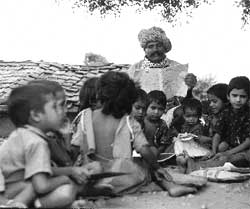Learning made easy
 long before the 83rd Constitutional Amendment Act-1997, making primary education a fundamental right, was tabled in the Indian Parliament, the state of Madhya Pradesh had embarked on an innovative scheme called Education Guarantee Scheme ( egs ) in January 1997. This guarantees education to citizens on demand, and also aims at universalising primary education by the year 2000. Under the scheme, when a group of people in rural areas of the state demand education for their children, the government is bound to provide basic education facilities.
long before the 83rd Constitutional Amendment Act-1997, making primary education a fundamental right, was tabled in the Indian Parliament, the state of Madhya Pradesh had embarked on an innovative scheme called Education Guarantee Scheme ( egs ) in January 1997. This guarantees education to citizens on demand, and also aims at universalising primary education by the year 2000. Under the scheme, when a group of people in rural areas of the state demand education for their children, the government is bound to provide basic education facilities.
Inspired by the Employment Guarantee Scheme of Maharashtra, (whereby the state has to provide work to rural labourers on demand), the scheme empowers the community to enforce the obligation of the state to provide primary education. It also involves the community through resources participation. Launched under the Rajiv Gandhi Shiksha Mission ( rgsm ), 11,579 new schools have been set up, and about 350,000 children have enrolled within six months of its commencement. Most of these schools have come up in tribal villages. In district Jhabua, 1,124 schools have been set up, while 1,412 and 779 schools have come up in the neighbouring districts of Khargone and Dhar.
Under the egs , the state government guarantees an educational facility if:
l The demand for the educational facility is from a rural area;
l There are no schooling facilities (government or private primary schools both in formal or non-formal education) within a radius of one km;
l The number of children aged between 6 and 14 years is at least 40 (25 in tribal areas); and
l The local community raises a demand for an educational facility.
As the principles of the scheme are decentralisation and community participation, the Gram Panchayat (village council) will not only be the nodal agency to manage the school but also provide the space for the school. The school remains open for at least 200 days a year. Timing and vacation period are decided by the community according to suitability.
"The egs caters to area-specific problems of the state in the education sector,' explains Amita Sharma, director, rgsm , and member secretary of the state-level egs coordination committee. "The scattered pattern of tribal villages makes it virtually impossible for government agencies to go in for a formal education system. Even if you make it, chances of success are bleak,' she adds. A typical tribal village consists of several scattered hamlets that are typified by high dropout rate. So the egs is an effective alternative that is non-formal and puts the onus of education on the community. "The egs confirms that without community awareness and active participation, the access to primary education is not utilised,' says Sharma.
You have to walk five km from the main road to reach Malphalia village in district Jhabua. It was one of the first villages to raise the demand of a school under the egs . The school started on May 1, the premises being provided by a villager. According to Surbha, the sarpanch (panchayat chief) of the village, all children who enrolled had earlier dropped out of a formal primary school 10 km away.
It is a pleasing sight. Exactly 19 students gather every morning in the backyard of Dhirma's home, who has provided it for the school. Ram Singh Basnia, the teacher, uses a "different' method. "In this school, we do not teach from text books. Instead, emphasis is put on methods that are
Related Content
- Integrated systems research for sustainable smallholder agriculture in the Central Mekong: achievements and challenges of implementing integrated systems research
- These low cost mobile weather stations can help cope with floods, landslides
- Delhi’s new Master Plan should be made easy to understand: Kamal Nath
- Blow hot and cold
- A foreign vocabulary
- Hush!
